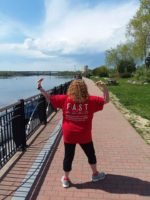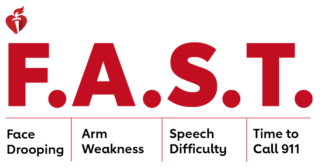 Tamara Osgood, an Environmental Services Tech at a Maine hospital, didn’t realize at the time that she was experiencing Transient Ischemic Attacks (TIAs). Despite seeing stroke warning signs posted throughout the hospital halls, it never occurred to her that she could suffer a stroke.
Tamara Osgood, an Environmental Services Tech at a Maine hospital, didn’t realize at the time that she was experiencing Transient Ischemic Attacks (TIAs). Despite seeing stroke warning signs posted throughout the hospital halls, it never occurred to her that she could suffer a stroke.
She would think, “stroke is the droopy face, right? Well, I never experienced that.” Instead, her face tingled from time to time. She recalls that a month prior to her stroke, she felt confused and disoriented. On a couple of occasions, she knocked over drink while trying to pick it up.
Meanwhile, Tamara had been eating healthier and working out over the prior year. She had managed to lose roughly 40 pounds when she hit a plateau, so she decided to add weight training to her workout routine.
The day after her 45th birthday, she awoke with a heavy arm. She laughed it off thinking, “so this is what 45 feels like?” Her arms felt heavy for a few more days, which she had attributed to some strength training she did the day before her birthday. Two weeks passed with no improvement, so she made an appointment to see her doctor who diagnosed her with carpal tunnel and prescribed some physical therapy (PT) sessions.
Two weeks into therapy, she saw no improvement and was feeling worse. All this time, she was driving to and from work, working overtime and working out on a treadmill. Upon waking one morning, her hand would not straighten. It resembled a claw and felt extremely cold. She struggled with putting on makeup and getting dressed and needed help tying her sneakers. She drove herself to work.
Once at work, she struggled with donning her small gloves. Determined to work, she tried larger gloves, but still couldn’t get her fingers into them. After several minutes trying, she came to conclusion that she couldn’t work. She started crying feeling badly about losing her perfect attendance at work and because she was scared and frustrated that her hand had gotten worse. Upon leaving, her supervisor suggested getting her hand checked out. She said already have a scheduled physical therapy for tomorrow. She then proceeded to drive herself home.
The next day at PT, Tamara showed her hand to the therapist who said, “we better hold off on doing PT today, however, I’d like for occupational therapist to see you”. The OT gave her a strength test on both of hands and found her left hand was very weak. Both therapists urged her to see her primary care physician, but she was out until Monday. So, she went home.
Tamara called out of work for the weekend again messing up her perfect attendance. Over the weekend, she wrapped her hand up to keep it warm and elevated and kicked back in her recliner. On Monday morning, her husband drove her to a scheduled PT appointment. Upon arriving, her therapist was shocked to see her and was concerned. She said, “you really need to get that checked out”. She and her husband said we they would go to the hospital.
After several tests and bloodwork, her husband explained that it’s like her brain isn’t communicating with her hand. An MRI was ordered. She recalls while having the MRI to figure out what’s going on with her arm and hand, they had stopped the test and then added a thing that looked like a football helmet and slid her back into machine. At this point while lying there in the MRI, she was thinking “oh my God, they think something is wrong with my brain! Oh my God!” She still was not thinking it could be a stroke. But, unfortunately, it was.
She had a mild right ischemic stroke that affected her brain’s temporal, parietal, and frontal lobes. As a result, she struggles with the use of her left arm and hand as well as with some cognitive abilities and memory.
“You’ve got to get the mind and body active, period. It wasn’t easy in the beginning with post-stroke fatigue and the depression in the beginning, but it does get easier with time, dedication and determination,” said Tamara. “I am stubborn and a go-getter!”
Looking back, Tamara had some risk factors for stroke including being overweight, having high blood pressure, high cholesterol, taking birth control pills and she was also a light smoker at the time. She also has a family history of stroke and heart disease.
She stresses the importance of everyone knowing the F.A.S.T. Warning Signs to spot a stroke:
F = Face Drooping – Does one side of the face droop or is it numb? Ask the person to smile. Is the person’s smile uneven? In Tamara’s case, she had tingling that came and went.
A = Arm Weakness – Is one arm weak or numb? Ask the person to raise both arms. Does one arm drift downward?
S = Speech Difficulty – Is speech slurred?
T = Time to call 911 – Record last time yourself or person first started experiencing symptoms.
SEEK IMMEDIATE ATTENTION -DO NOT DRIVE YOURSELF! CALL 911 by doing so they may be able to treat you quickly with a tPA- a fast-acting, clot-busting drug.
Other Stroke Symptoms include any of these symptoms that come on suddenly:
• NUMBNESS or weakness of face, arm, or leg, especially on one side of the body
• CONFUSION, trouble speaking or understanding speech
• TROUBLE SEEING in one or both eyes
• TROUBLE WALKING, dizziness, loss of balance or coordination
• SEVERE HEADACHE with no known cause
For more information, visit Stroke.org.